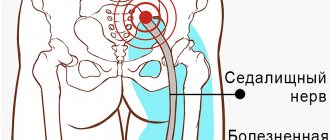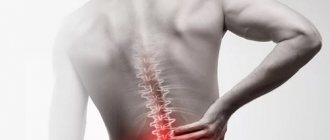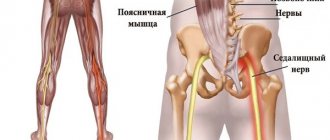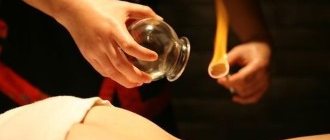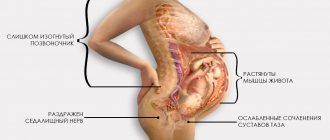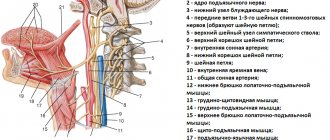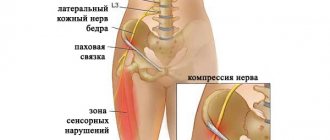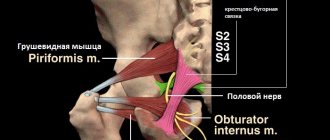A nerve block is the local administration of anesthetic and anti-inflammatory drugs to relieve pain and reduce inflammation. The procedure is used when acute pain occurs. Sciatica is one of the diseases for which blockade is prescribed. Since this disease causes pinching of the sciatic nerve with inflammation, the goal of the procedure is to block the sensitivity of this particular nerve.
Warning
. The decision to carry out a blockade is made only by the doctor. The procedure should only be performed by qualified medical personnel. Without being a specialist in the medical field, it is difficult not only to give the injection correctly, but even to find the injection site for the medicine. A nerve block is not an ordinary medical injection that can be given by a non-specialist. This is a complex manipulation that requires very careful execution. Otherwise, you can cause harm to the body.
What is a blockade for a pinched sciatic nerve?
The principle of operation of this procedure is the formation of a local analgesic block, that is, blocking the pain impulse to other parts of the central nervous system. There are several known methods that are used to relieve severe pain when the sciatic nerve is pinched. The most used of them is blockade. So, is a blockade performed when the sciatic nerve is pinched? A blockade is a technique that uses medications in the form of injections to treat severe pain in a patient. It is prescribed for pinched sciatic nerves, if therapy does not improve the condition, and the pain syndrome in a person does not allow a person to live a full life.
Indications for use
The blockade is used for severe sciatica, when physiotherapy and medication therapy are not effective. The use is necessary because the patient continues to experience severe pain that cannot be blocked by taking analgesics. Other indications for blockade: pinched nerve, injury to this area, neuralgia or other factor causing unbearable pain; muscle spasms or contracture; overloaded ligament system; local trophic disorders.
Types of therapeutic and diagnostic blockades
Local
The injection is made into the affected area, under or around the lesion, into the area of altered tissue reactions, into inflammation, etc. They are divided into periarticular (in the tissue near the joints) and perineural (into the nerve canals).
Segmental
Injections into various segments, these include paravertebral blockades, which are given in the projection of segments of the spine. Each spinal nerve and spinal segment corresponds to a dermatome (a section of the skin, connective tissue), a sclerotome (an area of the skeletal system), and a myotome (part of the muscular system). By injecting the drug intradermally into any dermatome, it is possible to influence the corresponding part of the spine and/or internal organ. The most common indication is myotonic reactions of paravertebral muscles in osteochondrosis.
Vertebral
This therapeutic blockade combines several techniques in neurology. Used for back pain. The anesthetic can be injected intradermally, between the spinous processes of the vertebrae to a depth of 2-4 cm, into the area of the vertebral body. In the latter case, they retreat 3-4 cm to the side from the line of the spinous processes. The needle is directed at an angle of 35° and inserted 8-10 cm in depth.
Spinal blocks
Severe pain in the spine is associated with pinched spinal nerves. The blockade acts in a targeted manner and normalizes well-being. This is not a simple procedure, so it is carried out only as a last resort.
During the blockade, the nerve conduction of certain fibers is temporarily switched off. To do this, local anesthetics are used, which block cellular conduction by inhibiting voltage-dependent sodium pathways.
The procedures are indicated for disc protrusion, osteochondrosis, neuralgia, intervertebral hernia, myositis, spondyloarthrosis. Spinal blocks are cervical, thoracic, thoracolumbar, sacrolumbar, coccygeal, paravertebral. The latter are divided into intradermal and subcutaneous (numb the skin near the spine), intramuscular (relieve muscle spasm and inflammation), perineural ("turn off" the affected nerve).
The effect occurs in a few minutes. At the same time, vascular spasm is reduced, tissue restoration is accelerated, metabolism is normalized, and swelling from inflammation goes away.
Heel spur blocks
Used to relieve inflammation of the heel fascia. The injection is made into the heel spike, in the very center. Hormone-based medications are used. The effect is instant. The difficulty lies in the bone-salt structure of the spine, which complicates the process. The doctor must be highly qualified and experienced. Steroids not only relieve inflammation, but also “accelerate” metabolism. Due to the latter, the bone growth is reabsorbed. Most often, one of three glucocorticosteroids is used: Hydrocortisone, Diprospan or Kenalog. The effectiveness of the method depends 90% on the correct injection. Therefore, the procedure is carried out under ultrasound control. It is extremely painful, so local anesthesia with Ultracaine, Novocaine or other similar medicine is first provided. After the injection, do not step on your heel for 30-60 minutes. Next, to reduce pressure on the heel fascia, special insoles are used.
Joint blocks
They are used for small and large joints when pain is a consequence of a degenerative process or inflammation. The anesthetic is injected into the joint capsule. After this, the pain is completely eliminated. If the case is advanced, then it is significantly reduced. The main indications are bursitis, osteoarthritis of the joints, periarthritis, arthritis of a non-infectious nature, tenosynovitis. The procedure does not require preparation and is performed under local anesthesia. Duration – 20 minutes. The effect occurs within a few minutes. Immediately after administration of the drug, you can move. The duration of the effect depends on the degree of damage to the joint. It averages 21 days. Then repeated blockades are made. Sometimes injections are made not into a joint, but into a muscle. This is necessary to reduce the spasm that causes pain. This group also includes paravertebral blockades. The following joints are treated using this technology: ankle, hip, wrist, knee, shoulder, elbow.
Nerve blocks
An anesthetic is injected into the area along which the peripheral nerve travels. This eliminates pain, vascular spasm, muscle tension, inflammation and swelling. Indications: neuritis, neuralgia, oncology, joint pathologies, muscular-tonic and tunnel syndromes. The procedure can be performed under ultrasound guidance. Duration – up to 10 minutes. The analgesic effect occurs within a few minutes and lasts up to 21 days. Repeated procedures can be performed, except in cases where the effect does not occur after 1-2 injections.
What drugs are used for blockade?
Does a blockade help with a pinched sciatic nerve? This is evidenced by positive reviews from patients who have used this type of therapy. When carrying out a blockade when the sciatic nerve is pinched, various drugs are used.
Novocaine
Novocaine blockade for pinched sciatic nerve is considered the most commonly used. Novocaine allows you to block irritation of the sciatic nerve and turn off the sensitivity of accompanying nerve endings, remove pain and improve tissue structure. The novocaine blockade contains auxiliary substances, such as trimecaine and dicaine, to enhance the effect of the main component. As well as 8% gelatin solution and ethyl alcohol to increase exposure time.
Lidocaine
Lidocaine is also often used to block the pinched sciatic nerve. Its action is considered even slightly less effective than novocaine, but less toxic. In particular, 0.25 or 0.5 percent solutions are used, in volumes of 80 ml and 40 ml, respectively. You can prolong the effect of lidocaine with hormonal drugs, as well as adrenaline, since its action causes spasm of blood vessels and prevents the rapid absorption of drugs.
Diprospan
Diprospan is a hormonal drug, the use of which relieves swelling and inflammation in the sciatic nerve, relieves pain, and improves blood circulation in the affected area. The downside is that the body gets used to it with frequent use.
Diclofenac
Diclofenac has anti-inflammatory, antipyretic, analgesic, antirheumatic effects, which helps relieve pain and inflammation in the sciatic nerve.
Side effects of the procedure
Experts include the following possible conditions as side effects:
- dizziness, loss of energy, headache and fatigue;
- decrease in blood pressure and all the accompanying features of well-being;
- skin rash, allergic dermatitis;
- it is possible to develop mild numbness and tingling in the limbs, which are explained by the effect of the administered medications;
- anaphylactic shock;
- infection at the injection site.
Technique of the procedure
Where is the blockade done when the sciatic nerve is pinched? The most well-known and accessible technique is the introduction of a blockade at the Voino-Yasenetsky point, located directly above the nerve. To find this point, you need to draw two lines with the patient lying down: the horizontal line is drawn along the top of the greater trochanter, and the vertical line is drawn through the outer edge of the ischial tuberosity. It is at their intersection. Only those prescribed by a neurologist
solution gradually, directing the needle to the sciatic nerve. It is recommended to add corticosteroids to increase the duration of action of pain medications.
Possible complications
There are situations when the correctness of the procedure is violated. Then there is a possibility of developing complications of sciatic nerve blockade:
- Traumatization of the fiber itself . It occurs when the nerve is directly punctured by a needle during an injection. This is very painful and requires immediate medication and physical therapy on the affected area of the nerve trunk. In difficult cases, it may be necessary to restore its integrity through surgery. The most negative consequence is impaired motor activity of the limb, up to paralysis.
- Broken needle during injection . If the patient jerks sharply, the needle may break at the base. If a piece of metal remains in the patient's body, immediate surgical removal is indicated. Otherwise, the wound may fester.
- Damage to a large blood vessel during the procedure . Then both a hematoma and heavy bleeding may develop. It all depends on the severity of the lesion. Symptomatic treatment is indicated. One of the worst consequences is the development of necrosis in the muscles due to impaired blood circulation
Expert opinion Mitrukhanov Eduard Petrovich Neurologist, city clinic, Moscow. Education: Russian State Medical University, GBOU DPO Russian Medical Academy of Postgraduate Education Ministry of Health of the Russian Federation, Volgograd State Medical University, Volgograd. If the doctor performing the sciatic nerve block is sufficiently qualified, the possibility of complications is minimal.
Contraindications for blockade
Each type of blockade has its own contraindications, because medications are far from “harmless”. Thus, the use of lidocaine and novocaine is prohibited for hypotension, cardiac arrhythmias, heart problems, liver failure, myasthenia gravis, second and third degree atrioventricular block, convulsive syndrome as a reaction to these drugs in the past, pregnancy and individual intolerance to the components of the solutions. Contraindications to the use of diclofenac are allergic reactions, diseases associated with hematopoiesis, stomach ulcers, inflammation of the digestive system, renal and liver failure, pregnancy and lactation period. It is also undesirable to use diclofenac for heart disease, such as ischemia.
Indications for blockade
At the initial stage of the disease, a therapeutic effect can be achieved through the use of ointments, tablets, and physiotherapy. However, if the listed treatment methods are ineffective, the patient is prescribed nerve blocking with painkillers and anti-inflammatory drugs.
Indications for nerve block are
- Severe, unbearable pain.
- Metabolic and nutritional disorders (trophic processes) in tissues.
- Inflammatory process.
- Ligament overload.
- Muscle spasms.
Prevention
Physical activity is the best way to prevent the onset of the disease. In addition to physical exercise, you must:
- Adhere to a rest and work schedule. If there is discomfort in the lower back, you should not sit on a low and soft chair. You need to sleep on a hard orthopedic mattress. It is also necessary to avoid wearing high-heeled shoes.
- Sign up for swimming, strengthen the muscles and spinal column with the help of various gymnastic exercises, which are the prevention of infringement.
- You need to lift heavy objects carefully and not jerkily.
- Avoid hypothermia of the lumbar region.
- Watch your figure, as excess weight can cause illness.
If the disease has already been diagnosed, you need to strictly adhere to medical prescriptions, and then recovery will go faster and no complications will arise. Be healthy.
Why do they contact us?
- No queues
No need to wait, we work by appointment
- All in one day
Doctor's appointment, diagnosis and treatment on the day of treatment
- Let's relieve the pain
We will help you relieve pain in just 1-2 visits to us
- We guarantee
Professional approach, affordable prices and quality
- Doctor's appointment 0 RUB!
During course treatment all consultations are free
- Three treatment options
We will select several options and offer optimal treatment
How to speed up the treatment process?
Advertising:
It is strictly forbidden to prescribe injections to yourself without consulting a treating specialist for neuritis. Only he will be able to select the correct and safe dose that will not cause side effects or serious complications. During injections, you can follow these recommendations to speed up the recovery process:
- Do regular or cupping massage regularly. It is best to use anti-inflammatory warming ointments for this.
- Apply with heated wax. This is very simple to do: treat the skin of your back with any fat, and then apply heated beeswax to it. Apply in several layers, then cover your back with cellophane and wrap yourself in a warm blanket. When the wax has cooled completely, you can remove it.
- Rub your back with tincture of pine buds or dandelion flowers. You can prepare it yourself or find it in any pharmacy.
- Don't forget to exercise regularly. When the pain subsides, sit on your buttocks and move around the room, do a bicycle, rotate your hips, stretch. This way you can get your muscles back into shape.
A qualified physician can determine effective medications and treatment for sciatic nerve pain, the symptoms of which are pain. We strongly do not recommend giving yourself injections at home.
External signs of pinching
Back pain is a clear symptom of
that a person is faced with inflammation of the sciatic nerve.
It is usually paroxysmal and significantly intensifies with physical activity or any movement. People who have already encountered this problem can characterize this discomfort as sharp, burning, sharp and stabbing sensations that intensify with the slightest movement. At the very beginning of the development of the disease, the pain is localized in one place, usually in the lower back, but over time it spreads to the hips, buttocks, and can stretch straight to the foot. You can recognize this problem by:
Advertising:
- Changes in gait
- a sick person tries to lean and lean on the healthy side. Because of this, his gait changes, and his walking speed also slows down significantly. The person begins to bend the leg on the side affected by inflammation. - Decreased sensitivity
- due to the fact that the nerve cannot function normally, not all nerve impulses enter the brain. However, this can also work in the opposite direction, when the slightest touch seems like a powerful gift to a person. - A burning sensation and a feeling of numbness
- due to the fact that a person begins to feel bad about his legs, he may fall or stumble out of the blue. In this regard, he is constantly looking for external support. - Weakness of the muscular skeleton on the affected side
- due to the fact that the nerve column is damaged, the nerve endings cannot receive all nerve impulses.
It should be noted that the pain caused by sciatica can vary. At the very beginning of the development of the pathology, a person feels slight discomfort, then the discomfort becomes similar to that that arises due to blowing. Over time, the patient may become completely immobile, because any movement brings serious pain.
Advertising:
How is the examination and diagnosis carried out?
If sciatica is suspected, a neurologist examines the lumbar and sacral areas, then, using special instruments, evaluates the sensitivity, tone and strength of the muscles along the sciatic nerve. The doctor also asks the patient to perform a series of simple exercises in order to determine the nature of the pain based on clinical signs. Pinched sciatic nerve requires surgical treatment in the neurosurgery department or in a specially equipped neurologist's office, since the condition threatens loss of sensation in the legs and complete immobility.
To clarify the diagnosis, it is necessary to identify all associated factors. For this, additional studies are prescribed:
- blood and urine tests;
- radiography;
- tomography;
- consultations with specialized specialists (rheumatologist, vertebrologist, vascular surgeon).
Nonsteroidal anti-inflammatory drugs
Using NSPV
It will be possible to quickly get rid of the source of inflammation.
The active ingredients of such drugs act on the root of the nerve ending, where pain occurs. The most popular injections of this group are Diclofenac and Movalis
. Also, incorrectly selected therapy causes serious complications that endanger the patient’s life. For this reason, there is no need to waste time on therapy with folk remedies.
Folk remedies do not have the same effectiveness as medicinal anti-inflammatory drugs.
Advertising:
Artrosan will help get rid of shooting neuralgia in the back and throughout the body
.
This drug is the most modern of the group of non-steroidal anti-inflammatory drugs. With the help of such injections it is possible to quickly relieve inflammation and relieve pain. Such drugs are administered intramuscularly. On average, a course of full therapy takes about 7 injections
. Already by the 3rd procedure, the patient practically does not feel pain or discomfort. It must be remembered that pregnancy is an absolute contraindication to such treatment.

